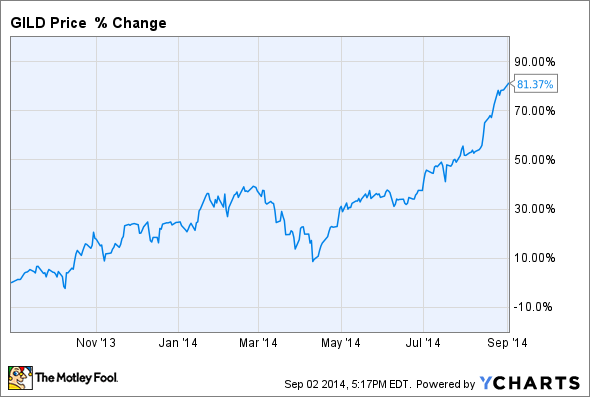Gilead Sciences' (GILD 0.23%) stock is a trading at all-time highs, up more than 80% over the last year on the back of a very successful launch of the company's hepatitis C drug Sovaldi. A few weeks ago, I shared three reasons Gilead's stock could go even higher.
Now here are three reasons why the stock could fall. While none of these may come to fruition, it's important for investors to be aware of the potential pitfalls.
1. Price wars

Source: Gilead Sciences.
Sovaldi doesn't have any real competition at the moment. Johnson & Johnson's (JNJ -0.46%) Olysio treats the same patients, but the drug's second-quarter sales were about a tenth of the $3.5 billion that Sovaldi produced. And most of Olysio's use seems actually to be in combination with Sovaldi.
But more competition is on its way. AbbVie (ABBV -4.58%) should have an all-oral cocktail approved shortly. The company has indicated it's not interested in getting into a price war, dragging down the price of the treatments, but that could change if AbbVie struggles to gain traction. The Sovaldi all-oral cocktail, which should also be approved by the FDA shortly, is arguably a better drug based on convenience, if nothing else.
Bristol-Myers Squibb (BMY 0.34%) might be a more likely spoiler of the high-price-treatment party. Gilead spited the pharma by choosing not to pursue a combination of Bristol's Daklinza with Sovaldi despite strong clinical trial data. Gilead already had an all-oral cocktail and didn't really need Bristol-Myers Squibb, which developed a combination of its own, which is not nearly as good as a Daklinza-Sovladi combination. Discounted pricing might be the only way to get doctors to prescribe Bristol's combination.
2. Poor execution of its diversification plan
Since hepatitis C treatment is a cure, patients only have to take the drug once unless they are infected again, which should be a dwindling problem as more and more people are cured. Gilead is eventually going to run out of hepatitis C patients to treat.
The eventual downturn is many years away, but Gilead Sciences needs to diversify away from hepatitis C for its next growth story.
It has already tried to diversify with its cardiovascular franchise, but Letairis and Ranexa are only a blockbuster when their sales are combined, and they hardly move the revenue needle that's on target to break $21 billion this year.
Gilead's oncology pipeline is its best diversification prospect. The company recently got Zydelig approved by the FDA, but it's going to take quite a few more oncology drugs to fill the void that its hepatitis C drugs will leave. Beyond Zydelig, Gilead Sciences has four oncology drugs in its pipeline, but only one is in phase 3 development.
3. Side effects
The downside of being so dependent on one drug is that any hiccup will be a major issue for Gilead Sciences. Merck fell substantially when it had to pull Vioxx off the market in 2004, and Sovaldi is arguably much more important to Gilead than Vioxx was to Merck.
It's hard to handicap the likelihood of a side effect not seen in the clinical trials suddenly popping up once the drug is used on a larger population, but it's certainly quite low. There's no reason this threat should keep investors up at night, but at the same time shareholders have to be compensated for taking on the risk -- however low -- of a potential disaster.
From an investment standpoint, the easiest way to do that is to ensure the margin of safety for a biotech company is wider than it would be for companies in other industries. If you'd normally buy if the expected return was 8%, you'd want to expect 10% returns for a biotech. For a company like Gilead Sciences that is so dependent on one drug, you'd want even higher expected returns.



